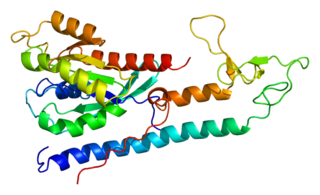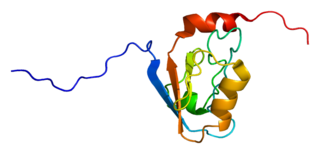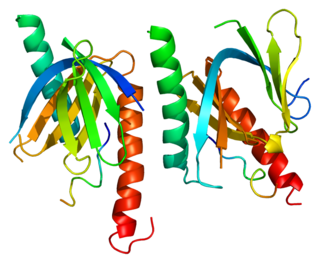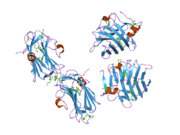
Neurexins (NRXN) are a family of presynaptic cell adhesion proteins that have roles in connecting neurons at the synapse. They are located mostly on the presynaptic membrane and contain a single transmembrane domain. The extracellular domain interacts with proteins in the synaptic cleft, most notably neuroligin, while the intracellular cytoplasmic portion interacts with proteins associated with exocytosis. Neurexin and neuroligin "shake hands," resulting in the connection between the two neurons and the production of a synapse. Neurexins mediate signaling across the synapse, and influence the properties of neural networks by synapse specificity. Neurexins were discovered as receptors for α-latrotoxin, a vertebrate-specific toxin in black widow spider venom that binds to presynaptic receptors and induces massive neurotransmitter release. In humans, alterations in genes encoding neurexins are implicated in autism and other cognitive diseases, such as Tourette syndrome and schizophrenia.

Syntaxin-1A is a protein that in humans is encoded by the STX1A gene.

AP-2 complex subunit alpha-1 is a protein that in humans is encoded by the AP2A1 gene.

Ras-related protein Rab-3A is a protein that in humans is encoded by the RAB3A gene. It is involved in calcium-triggered exocytosis in neurons.

Disks large homolog 3 (DLG3) also known as neuroendocrine-DLG or synapse-associated protein 102 (SAP-102) is a protein that in humans is encoded by the DLG3 gene. DLG3 is a member of the membrane-associated guanylate kinase (MAGUK) superfamily of proteins.

Amyloid beta A4 precursor protein-binding family A member 1 is a protein that in humans is encoded by the APBA1 gene.

Amyloid beta A4 precursor protein-binding family A member 2 is a protein that in humans is encoded by the APBA2 gene.

Regulating synaptic membrane exocytosis protein 1 is a protein that in humans is encoded by the RIMS1 gene.

Neuroligin-3 is a protein that in humans is encoded by the NLGN3 gene.

Rabphilin-3A is a protein that in humans is encoded by the RPH3A gene. It contains two C2 domains and binds calcium ions at low micromolar concentration. Rabphilin was shown to regulate neurotransmitter release in hippocampal neurons after neurons had an increased synaptic activity and their release rate was depressed.

Neuroligin-1 is a protein that in humans is encoded by the NLGN1 gene.

Neurexin-2-alpha is a protein that in humans is encoded by the NRXN2 gene.

Neurexin-3-alpha is a protein that in humans is encoded by the NRXN3 gene.

Synaptotagmin-5 is a protein that in humans is encoded by the SYT5 gene.

Neurexophilin-1 is a protein that in humans is encoded by the NXPH1 gene.

Neuroligin-2 is a protein that in humans is encoded by the NLGN2 gene.

N-terminal EF-hand calcium-binding protein 3 is a protein that in humans is encoded by the NECAB3 gene.

Synaptotagmin-7 is a protein that in humans is encoded by the SYT7 gene.

Neuroligin (NLGN), a type I membrane protein, is a cell adhesion protein on the postsynaptic membrane that mediates the formation and maintenance of synapses between neurons. Neuroligins act as ligands for β-neurexins, which are cell adhesion proteins located presynaptically. Neuroligin and β-neurexin "shake hands", resulting in the connection between two neurons and the production of a synapse. Neuroligins also affect the properties of neural networks by specifying synaptic functions, and they mediate signalling by recruiting and stabilizing key synaptic components. Neuroligins interact with other postsynaptic proteins to localize neurotransmitter receptors and channels in the postsynaptic density as the cell matures. Additionally, neuroligins are expressed in human peripheral tissues and have been found to play a role in angiogenesis. In humans, alterations in genes encoding neuroligins are implicated in autism and other cognitive disorders. Antibodies in a mother from previous male pregnancies against neuroligin 4 from the Y chromosome increase the probability of homosexuality in male offspring.

Neurexophilin-3 is a protein that in humans is encoded by the NXPH3 gene.




























